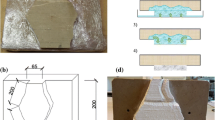Abstract
Electrokinetic desalination is a method where an applied electric DC field is the driving force for removal of salts from porous building materials. In the present paper, the method is tested in laboratory scale for desalination of single ceramic tiles. In a model system, where a tile was contaminated with NaCl during submersion and subsequently desalinated by the method, the desalination was completed in that the high and problematic initial Cl− concentration was reduced to an unproblematic concentration. Further conductivity measurements showed a very low conductivity in the tile after treatment, indicating that supply of ions from the poultice at the electrodes into the tile was limited. Electroosmotic transport of water was seen when low ionic content was reached. Experiments were also conducted with XVIII-century tiles, which had been removed from Palacio Centeno (Lisbon) during renovation due to damage of the glazing from the presence of salts. These tiles were severely contaminated with both chlorides and nitrates, and one of the tiles also contained sulphates though at a low concentration. The charge transfer was too low in the experiments to obtain full desalination, but promising results were obtained as significant decreases (>81% Cl−, ~59% NO3 − and ~22% SO4 2−) were seen.










Similar content being viewed by others
References
Sawdy A, Heritage A, Pel L (2008) A review of salt transport in porous media, assessment methods and salt reduction treatments. In: Proceedings from the international conference on salt weathering on building and stone sculptures, Copenhagen, Denmark, 22–24 October 2008. pp 1–27
Gomes MMM, Monteiro JP (1996) Conservation and restoration of Azulejos—Portuguese tiles. Ricardo do Espírito Santo Foundation, Lisbon
Mietz J (1998) Electrochemical rehabilitation methods for reinforced concrete structures. A state of the art report. European Federation of Corrosion Publications. Numer 24
Tritthart J (1998) Electrochemical chloride removal: an overwiev and scientific aspects. In: Skalny J, Mindess S (eds) Materials science of concrete V. American Ceramic Society, Westerville, OH, USA, pp 401–441
Velivasakis EE, Henriksen SK, Whitmore DW (1998) J Perform Constr Facil 12(2):77
Ottosen LM, Rörig-Dalgaard I (2009) Mater Struct 42:961–971
Ottosen LM, Rörig-Dalgaard I, Villumsen A (2008) Electrochemical removal of salts from masonry—experiences from pilot scale. In: Proceedings from the international conference on salt weathering on building and stone sculptures, Copenhagen, Denmark, 22–24 Oct 2008. pp 341–350
Rörig-Dalgaard I, Ottosen LM (2008) Method and device for removing an ionic impurity from building structures (Pub. No. WO/2009/124890)
Rörig-Dalgaard I (2008) Preservation of masonry with electrokinetics—with focus on desalination of murals. PhD Thesis, Department of Civil Engineering, Technical University of Denmark
Yeung AT, Datla S (1995) Can Geotech J 32:569–583
Castellote M, Andrade C, Alonso C (2000) Cem Concr Res 30:615–621
De Clercq H (2008) The effect of other salts on the crystallization damage tos tone caused by sodium sulphate. In: Proceedings from the international conference on salt weathering on building and stone sculptures, Copenhagen, Denmark, 22–24 Oct 2008. pp 307–315
Ottosen LM, Rörig-Dalgaard I (2007) Electrochim Acta 52(10):3454–3463
Acknowledgments
Joao-Manuel Mimoso, Laboratorio Nacional de Engenharia Civil (LNEC) Portugal is acknowledged for supplying the XIX tiles for the experimental work and for the idea of testing electrokinetic desalination for salt contaminated tiles.
Author information
Authors and Affiliations
Corresponding author
Rights and permissions
About this article
Cite this article
Ottosen, L.M., Ferreira, C.M.D. & Christensen, I.V. Electrokinetic desalination of glazed ceramic tiles. J Appl Electrochem 40, 1161–1171 (2010). https://doi.org/10.1007/s10800-010-0086-x
Received:
Accepted:
Published:
Issue Date:
DOI: https://doi.org/10.1007/s10800-010-0086-x




